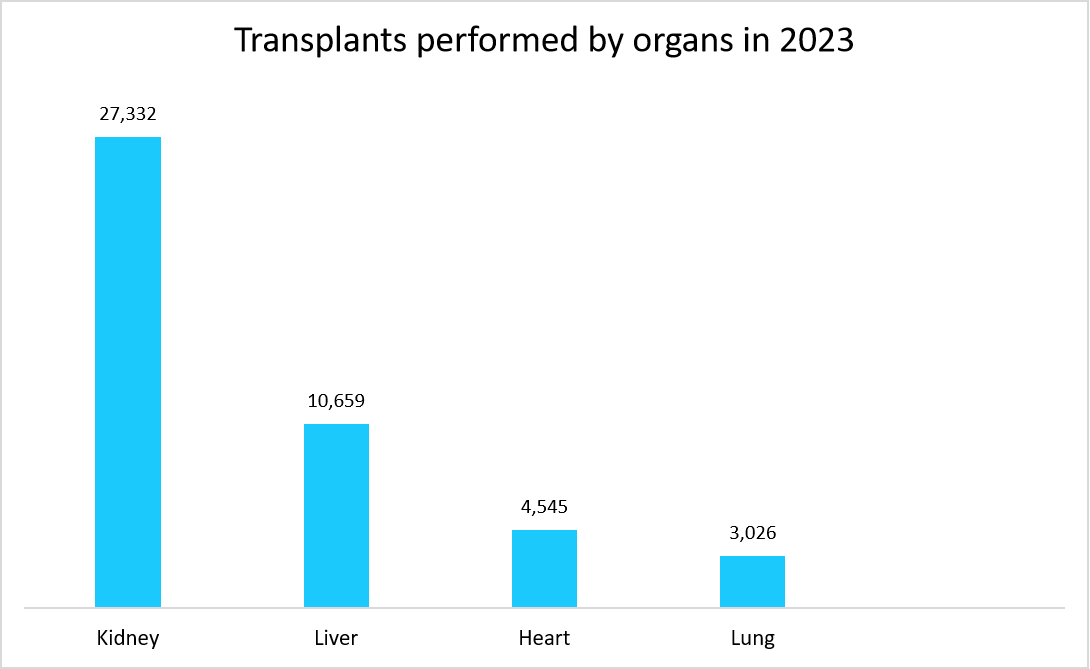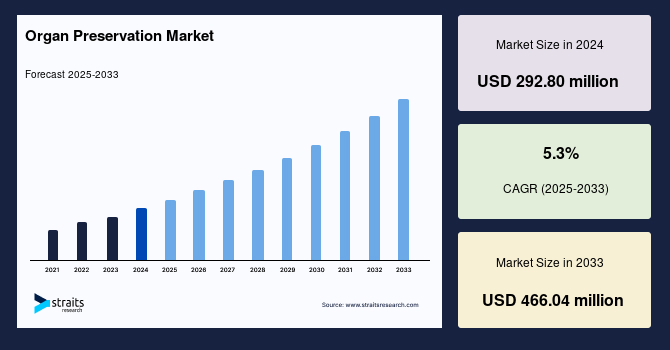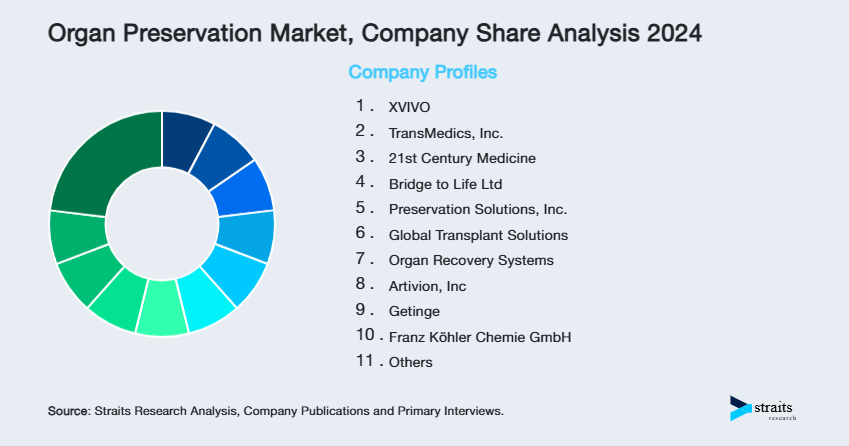Organ Preservation Market Size
The global organ preservation market size was valued at USD 292.80 million in 2024 and is anticipated to grow from USD 308.32 million in 2025 to reach USD 466.04 million in 2033, growing at a CAGR of 5.3% during the forecast period (2025–2033).
Organ preservation refers to the techniques and processes used to maintain the viability and function of organs outside the body for transplantation purposes. It is a critical component of organ transplantation, ensuring that organs remain in optimal condition during the time between donation and transplantation. Various methods of preservation, such as cold storage, hypothermic perfusion, and machine perfusion, help slow down metabolic processes, reduce cell damage, and extend the time an organ can be safely stored.
The market is experiencing rapid growth, driven by advancements in preservation techniques and increasing awareness of organ donation. The rising prevalence of chronic diseases such as kidney failure, liver cirrhosis, and heart disease is further accelerating the demand for effective preservation solutions. Moreover, the integration of digital monitoring technologies and AI-driven solutions is revolutionizing preservation by enabling real-time tracking and condition evaluation during transportation, ensuring optimal viability.
The below graph highlights the organ transplants performed in 2023

Source: Straits Research, Health Resources & Services Administration
As shown in the above graph, the demand for organ transplants is steadily increasing, with kidneys being the most commonly transplanted organ, followed by the liver, heart, and lungs. This growing need for transplants underscores the rising demand for advanced preservation technologies. The shift toward next-generation preservation methods presents significant opportunities for market players to develop high-performance strategies that enhance organ viability and improve transplant success rates.
Market Trends
Advancements in Normothermic Machine Perfusion (nmp) Technique
The adoption of NMP as an alternative to traditional cold storage is becoming a key trend in the global organ preservation market. Recent innovations in normothermic machine perfusion (NMP) are significantly improving organ viability, extending preservation times, and increasing transplant success rates. The ongoing collaboration between key industry players is driving technological advancements in this field.
- For instance, in November 2024, OrganOx and eGenesis announced an exclusive clinical co-development partnership to integrate NMP technology with genetically engineered porcine livers to assist the 35,000 U.S. patients admitted annually with acute liver failure. The PERFUSE-2 study demonstrated NMP's ability to sustain organ function, enabling liver recovery and transplantation.
By simulating physiological conditions, NMP enhances organ viability, improves transplant outcomes, and extends the donor pool, reshaping the future of transplantation.
Shift towards Vitrification and Nanowarming
The shift toward vitrification and nanowarming for long-term organ cryopreservation is gaining momentum as the demand for extended storage, improved logistics, and fewer geographical & time constraints in transplantation increases. This innovative method enhances organ viability, expands donor availability, and improves overall transplant efficiency.
- For instance, in June 2023, scientists pioneered a breakthrough in organ preservation by successfully transplanting vitrified and stored rat kidneys for 100 days using nanowarming technology. This method utilizes iron oxide nanoparticles to enable rapid and uniform heating, preventing ice crystal formation during rewarming.
The adoption of vitrification and nanowarming as a revolutionary trend is paving the way for longer organ storage times, reducing the urgency of immediate transplantation, and significantly improving patient outcomes.

To get more insights about this report Download Free Sample Report
Organ Preservation Market Growth Factors
Rising Prevalence of Organ Failure
The increasing incidence of organ failure is driving the demand for advanced organ preservation and transplantation technologies to enhance viability, storage, and transplant success rates. The rising burden of chronic diseases, traumatic injuries, and multi-organ failure (MOF) further underscores the need for improved preservation methods.
- In February 2023, a systematic review of 351,942 trauma cases over a decade revealed that 24% (82,971 patients) experienced organ failure, with incidence rates ranging from 11% to 56%. The study highlights the critical role of advanced organ preservation techniques in preventing MOF-related mortality and improving transplant outcomes.
Thus, as the prevalence of organ failure continues to rise, the demand for innovative preservation solutions is expected to grow, driving market expansion and improving patient survival rates.
Increasing Funding for Advanced Organ Preservation Methods
Growing investments in organ preservation technologies are a key driver of market growth, facilitating research advancements, regulatory approvals, and healthcare infrastructure development. Financial backing from both private investors and government bodies is accelerating innovation and commercialization in this sector.
- For example, in March 2023, Paragonix Technologies secured $24 million in Series B funding from Signet Healthcare Partners to scale its organ preservation technologies and expand market penetration. Notably, in 2022, over 20% of thoracic donor organs in the U.S. were preserved using Paragonix devices, demonstrating the growing adoption of advanced preservation methods.
This surge in funding is fueling the development of next-generation preservation technologies, improving transplant success rates, and contributing to the overall expansion of the market for organ preservation.
Restraining Factor
Shortage of Organ Donors
The widening gap between organ demand and supply remains a major challenge in organ transplantation. Despite medical advancements, the number of patients requiring transplants far exceeds the availability of viable donor organs. Low donor registration rates, stringent eligibility criteria, and organ wastage due to preservation limitations further exacerbate this shortage. Moreover, geographic disparities and transportation challenges hinder timely delivery, reducing transplant success rates and increasing mortality on waiting lists. These constraints not only limit access to life-saving transplants but also restrain market growth, highlighting the urgent need for improved donor programs.
Market Opportunity
Strategic Partnerships and Collaborations
Collaborations between organ banks, healthcare institutions, and biotechnology companies are fostering advancements in organ preservation technology. These partnerships drive innovation, expand the availability of viable organs, and enhance transplant success rates, creating significant growth opportunities for the market.
- For instance, in July 2024, BMI OrganBank partnered with Atrium Health and LifeShare Carolinas to develop the first organ banking technology in the U.S., focusing on room-temperature perfusion for kidney transplantation. This breakthrough aims to reduce organ damage caused by cold storage, improving viability and transplant outcomes.
Such strategic alliances are paving the way for cutting-edge preservation techniques, accelerating market growth, and addressing the growing demand for life-saving organ transplants.
Regional Insights
North America dominates the global organ preservation market, driven by its advanced healthcare infrastructure, rising organ transplant rates, and the presence of key market players. Ongoing research and development, coupled with government policies, further strengthen the region’s leadership.
- In March 2025, the National Collaboration Forum on Organ Machine Perfusion and Preservation convened in Tennessee, U.S., bringing together specialists to discuss emerging preservation technologies.
This highlighted the growing adoption of machine perfusion techniques, enhancing organ viability and expanding the donor pool. Moreover, the increasing prevalence of organ failure and an established procurement network solidify North America’s market dominance.
The U.S. leads the regional market, supported by its advanced healthcare system and high prevalence of chronic diseases. As of February 2025, 35.5 million Americans suffer from chronic kidney disease (CKD), with over 815,000 facing kidney failure. This growing need for kidney transplants accelerates demand for sophisticated organ preservation technologies, boosting market growth. Moreover, continuous advancements in preservation methods and an established healthcare infrastructure further drive the expansion of the U.S. organ preservation market.
Canada’s market is expanding, driven by increasing transplant demand and regulatory approvals.
- In October 2024, Health Canada approved the OrganOx Metra for liver transplants, with a commercial launch scheduled for 2025. This system enhances preservation time and streamlines transplant logistics.
The rising demand for liver transplants, coupled with supportive government policies, accelerates the adoption of advanced preservation technologies.
Asia Pacific Organ Preservation Market Trends
Asia Pacific is poised to witness the fastest growth, fueled by a rising incidence of chronic diseases such as diabetes, hypertension, and liver cirrhosis. Countries like China, India, Japan, and South Korea are making significant investments in healthcare infrastructure, advanced medical technologies, and transplant centers. Moreover, increasing organ donation initiatives, public awareness, and donor registration rates are driving market expansion.
- In August 2024, India’s Union Health Ministry organized the Chintan Shivir on organ and tissue donation reforms, focusing on improving technology, processes, and legislation.
China's market is growing due to technological advances and a rising incidence of chronic diseases. A study in February 2023 revealed that 81.1% of the elderly population suffers from chronic conditions, contributing to a growing burden of end-stage organ failure. As demand for organ transplants increases, so does the need for preservation technologies to improve organ viability. These trends are driving substantial market growth in China, making it a key player in the global organ preservation sector.
India is experiencing rapid growth in the organ preservation industry, driven by government initiatives, increased public awareness, and the establishment of retrieval banks.
- In March 2025, AIIMS Bathinda will launch an organ retrieval bank in Punjab to boost cadaveric transplants. Such projects, coupled with rising awareness of organ donation, fuel demand for advanced preservation technologies, making India a key emerging market for organ preservation in the global landscape.
Europe Organ Preservation Market Trends
The UK market is benefiting from advances in machine perfusion technologies, rising demand for transplant organs, and increasing investment in biotech companies.
- In February 2025, Oxford-based OrganOx raised $142 million to scale its Metra machine, which enhances liver viability for up to 12 hours. This breakthrough in preservation technology is expected to improve transplant success rates and drive the expansion of the market.
Solution Insights
The University of Wisconsin (UW) solution leads the global market due to its proven effectiveness in extending viability, minimizing ischemic damage, and enhancing post-transplant survival rates. As the gold standard for static cold storage, UW solution is widely used for preserving kidneys, livers, and pancreas, ensuring greater graft survival. Its rich composition of antioxidants and impermeants protects cells during ischemia, making it the preferred choice for transplant centers worldwide. Extensive clinical validation further reinforces its market dominance.
Organ Type Insights
The kidney segment dominates the market for organ preservation, driven by the high prevalence of end-stage renal disease (ESRD) and the increasing demand for kidney transplants. Kidneys have the highest transplant rate among all organs, necessitating advanced preservation techniques. For example, in 2023, the U.S. performed a record 27,332 kidney transplants, underscoring the need for continuous innovation in preservation methods to improve transplant success rates and address the growing kidney transplant waiting list.
Techniques Insights
Static cold storage (SCS) remains the leading global market due to its simplicity, cost-effectiveness, and widespread clinical adoption. As a standard method, SCS effectively preserves organs and supports high transplant success rates. For instance, a June 2023 review in Frontiers in Transplantation reaffirmed that SCS remains the clinical gold standard, ensuring reliable preservation and reducing ischemic damage. Its ease of use and efficiency continue to drive its dominance in the market.
Company Market Share
Key market players are actively adopting various business strategies to strengthen their position and drive market growth. These strategies include strategic collaborations, acquisitions, awareness programs, government initiatives, and product approvals and launches. By forming alliances with healthcare institutions, biotechnology firms, and research organizations, companies aim to accelerate innovation and expand their market reach.
Getinge: An Emerging Player in the Global Organ Preservation Market
Getinge is a Swedish medical technology company with expertise in healthcare and life sciences solutions. It offers products and services for intensive care, cardiovascular procedures, operating rooms, sterile processing, and life sciences. Moreover, the company specializes in enhancing clinical outcomes, optimizing hospital workflows, and improving patient care with cutting-edge medical technologies.
Recent Developments by Getinge:
- In August 2024, Getinge completed its USD 477 million acquisition of Paragonix Technologies, a specialist in organ transport solutions. Paragonix experienced 136% growth in 2023, and its heart preservation device lowered severe complications by 50% and 2-year mortality by 43%.
List of key players in Organ Preservation Market
- XVIVO
- TransMedics, Inc.
- 21st Century Medicine
- Bridge to Life Ltd
- Preservation Solutions, Inc.
- Global Transplant Solutions
- Organ Recovery Systems
- Artivion, Inc
- Getinge
- Franz Köhler Chemie GmbH
- Essential Pharmaceuticals, LLC
- OrganOx Limited
- Waters Medical Systems, LLC
- Carnamedica
- Vascular Perfusion Solutions, Inc.

To get more findings about this report Download Market Share
Recent Developments
- November 2024 – XVIVO's heart preservation technology reached full enrollment five months ahead of schedule, with 141 patients undergoing transplantation at 14 top transplant hospitals. This achievement underscores the growing use of hypothermic oxygenated perfusion (HOPE) technology, which preserves donor heart viability, including from older donors and long-distance sources.
- October 2024 – Bridge to Life Ltd and ULS Coimbra announced a partnership to improve liver preservation for transplantation, celebrating 32 years of operation of ULS Coimbra's liver transplant program. The program features video case studies of highly advanced procedures, reinforcing industry-academic collaboration. With VitaSmart's worldwide availability and FDA submission in 2025, similar developments lead to market growth, enhancing transplant success rates.
Analyst Opinion
As per our analyst, the global organ preservation market is poised for substantial growth, driven by an escalating demand for organ transplants, technological advancements in preservation methods, and increasing government initiatives to enhance organ donation rates. The shift from traditional cold storage to advanced perfusion technologies is significantly improving organ viability, extending preservation times, and boosting transplant success rates.
However, despite these positive trends, the market still faces several challenges, including the persistent shortage of donors, logistical issues in transportation, and disparities in donor registration rates across different regions. These barriers continue to restrict the widespread availability of viable organs, especially in areas with low donor participation.
Nonetheless, the global prevalence of organ failure, particularly due to chronic diseases, and the increasing demand for life-saving transplants are expected to drive continued growth. The focus on overcoming these challenges through technological innovations and policy support will further propel the market, ensuring its critical role.
Report Scope
| Report Metric | Details |
|---|---|
| Market Size in 2024 | USD 292.80 Million |
| Market Size in 2025 | USD 308.32 Million |
| Market Size in 2033 | USD 466.04 Million |
| CAGR | 5.3% (2025-2033) |
| Base Year for Estimation | 2024 |
| Historical Data | 2021-2023 |
| Forecast Period | 2025-2033 |
| Report Coverage | Revenue Forecast, Competitive Landscape, Growth Factors, Environment & Regulatory Landscape and Trends |
| Segments Covered | By Solution, By Organ Type, By Techniques, By Region. |
| Geographies Covered | North America, Europe, APAC, Middle East and Africa, LATAM, |
| Countries Covered | U.S., Canada, U.K., Germany, France, Spain, Italy, Russia, Nordic, Benelux, China, Korea, Japan, India, Australia, Taiwan, South East Asia, UAE, Turkey, Saudi Arabia, South Africa, Egypt, Nigeria, Brazil, Mexico, Argentina, Chile, Colombia, |
Explore more data points, trends and opportunities Download Free Sample Report
Organ Preservation Market Segmentations
By Solution (2021-2033)
- University of Wisconsin (UW)
- Histidine-Tryptophan-Ketoglutarate (HTK)
- Collins
- Others
By Organ Type (2021-2033)
- Kidneys
- Heart
- Lung
- Liver
- Others
By Techniques (2021-2033)
- Static Cold Storage
- Hypothermic Machine Perfusion
- Normothermic Machine Perfusion
- Others
By Region (2021-2033)
- North America
- Europe
- APAC
- Middle East and Africa
- LATAM
Frequently Asked Questions (FAQs)
Jay Mehta
Research Analyst
Jay Mehta is a Research Analyst with over 4 years of experience in the Medical Devices industry. His expertise spans market sizing, technology assessment, and competitive analysis. Jay’s research supports manufacturers, investors, and healthcare providers in understanding device innovations, regulatory landscapes, and emerging market opportunities worldwide.
Speak To AnalystAvailable for purchase with detailed segment data, forecasts, and regional insights.
Get This ReportOur Clients:










































